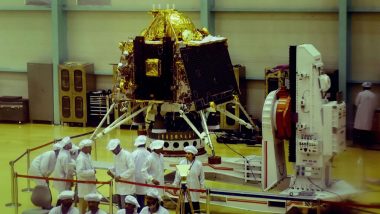Tirumala, July 14: The Chandrayaan 2 mission, India's second lunar mission, is all set to be launched on Monday, July 13 at 2.51 AM. The lunar mission will go where no country has ever gone before- the Moon's south polar region. Through this effort, the Indian Space Research Organisation (ISRO) aims to improve our understanding of the Moon- discoveries that will benefit India. The mission is believed to explore the dark side of the Moon after it lands on the cosmic body's south polar region. Chandrayaan 1 Team Reminisces Challenges Faced By Them As Second Moon Mission Team Gets Ready For Launch.
The 20-hour countdown for the lift-off of India's heavy rocket nicknamed the 'Bahubali' carrying the Chandrayaan-2 spacecraft began at 6.51 a.m. on Sunday. The 640-tonne rocket Geosynchronous Satellite Launch Vehicle-Mark III (GSLV-Mk III) which is about 44 metre tall, is nicknamed the 'Bahubali'.
The vehicle will act like the hero in the successful film lifts a heavy Lingam, the rocket will carry the 3.8-tonne Chandrayaan-2 spacecraft. About 16-minutes into its flight, the Rs 375 crore GSLV-Mk III rocket is expected to sling the Rs 603 crore Chandrayaan-2 into an Earth parking 170x40400 km orbit.
What is ISRO's Chandrayaan-2 Mission
Chandrayaan-2 is an Indian lunar mission that will go to the Moon's south polar region. This is India's second mission to the Moon, Chandrayaan-2, would be launched on July 15 from Satish Dhawan Space Center at Sriharikota in Andhra Pradesh. The total mass of the satellite is 3.8 ton and is expected to land on the Moon on September 6 or 7 this year." Chandrayaan 2 Launch: ISRO’s Low-Cost Moon Mission Puts India Among Lunar Pioneers.
Launch Time and Place
On Sunday, Chandrayaan-2 will be launched onboard the Geosynchronous Satellite Launch Vehicle Mk-III, or GSLV Mk-III, rocket in Andhra Pradesh's Sriharikota. Chandrayaan-II consists of an orbiter, a lander and a rover together referred to as "composite body". The total mass of the satellite is 3.8 ton and is expected to land on the Moon on September 6 or 7 this year.
Cost of Chandrayaan 2
According to reports, India has spent about $140 million to get Chandrayaan-2 ready for the 384,400 kilometres (around 240,000 miles) trip from the Satish Dhawan Space Centre to the scheduled landing on the lunar South Pole on September 6. With the launch of Chandrayaan 2 on Sunday, India will become only the fourth country to land a probe on the moon.
"In future, the nation will depend more on planetary missions. After Chandrayaan I mission, we are now entering into Chandrayaan II mission. We had slipped many times but now it will be launched on July 15 at 2.51 am," ISRO Chairman K Sivan had said.
ISRO Carries Out Checks
Ahead of the country's second mission to the moon, Indian Space Research Organisation (ISRO) on Thursday conducted checks at the launch pad of Chandrayaan 2 in Sriharikota.
Aim of Chandrayaan-2
The mission will also highlight how far space travel has advanced since Neil Armstrong's giant leap for mankind during the Apollo 11 mission. Chandrayaan-2 will explore a region of moon where no mission has ever set foot. The ISRO chief said the landing site, at about 70 degrees south latitude, is the southernmost for any mission till date. No country has attempted this before.
Why is Chandrayaan 2 Going to the Moon
The Moon is the closest cosmic body to the Earth at which space discovery can be attempted and documented. It is also a promising test to demonstrate technologies required for deep-space missions. Chandrayaan 2 attempts to foster a new age of discovery, increase our understanding of space, stimulate the advancement of technology, promote global alliances, and inspire a future generation of explorers and scientists. Chandrayaan-2 Launch: GSLVMkIII Carrying Moon Mission Spacecraft Undergoes Launch Checks at Sriharikota; ISRO Shares Image.
Watch: Chandrayaan-2: Here Are The Steps The Lunar Vehicle Will Undertake to Reach The Moon
The Chandrayaan- 2 includes a lunar orbiter, lander and rover, all developed indigenously. The mission will attempt a soft landing of a lander and rover in a high plain between two craters, Manzinus C and Simpelius N. The wheeled rover will move on the lunar surface and will perform on-site chemical analysis. It can relay data to Earth through the Chandrayaan-2 orbiter and lander, which will fly on the same launch.
(The above story first appeared on LatestLY on Jul 14, 2019 11:00 AM IST. For more news and updates on politics, world, sports, entertainment and lifestyle, log on to our website latestly.com).













 Quickly
Quickly


